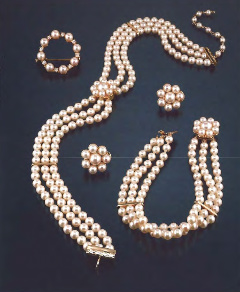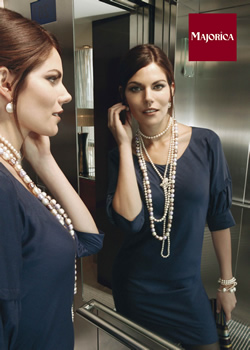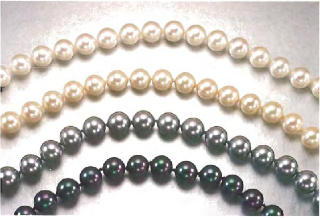Information on Majorica Pearls
Information on MAJORICA PEARLS from many sources all agree:
YOU DON'T NEED OYSTERS FOR PEARLS, GIRLS!
Read through the Majorica Pearl Questions & Answers sent in by AJI-Guests...
 "Lady Di" by Majorica Pearls S.A. "Lady Di" by Majorica Pearls S.A. |
 An Affordable Alternative to Natural Pearls An Affordable Alternative to Natural Pearls |
 The Four Main Colours of Imitation Majorica Pearls: White, Creme Rose, Grey and Black
The Four Main Colours of Imitation Majorica Pearls: White, Creme Rose, Grey and BlackThe great benefit of Imitation Pearls is these types of Pearls don't cost the earth compared to the price of, say, Natural Pearls. Imitation Pearls are completely man-made and in no way interfere with marine environments. This is an important consideration because environmentally switched on consumers are steering away from marine environments in search of softer pearl alternatives that leave no carbon sea-prints.
Antique & Estate Jewelry demonstrate how a sustainable relationship between women's jewelry , luxury and the planet can be achieved. Read about Dirty Gold- Mining if you still are not convinced.
Majorica, Mallorca, and Majorca are different terms all used to describe the same Imitation Pearl. They are imitation, man-made Pearls and made over 100 years ago on the Spanish island of Majorca in the Mediterranean.
Majorica Pearls was started reveals up by a Spainish company by the trade name "Majorica" and was founded in the year 1890 by a German immigrant by the name of Eduardo Hugo Heusch.
However, the Majorica Pearl story goes even further back in time to the 17th-century in Paris. Early production of these Pearls was first invented by a French rosary-bead maker, by the name of Jacquin who began the process of making artificial pearls using a hollow sphere of glass and lining them with a preparation made from fish scales which gave the glass beads a pearly lustre. He then filled the interior of the hollow sphere with wax to give it weight and strength.
Majorica pearls are a modern development of Jacquin's early pioneering efforts, producing a pearl imitation that has an appearance fairly close to a real Pearl.
The people who wear Majorica Pearls include the rich, famous and members of the British royal family; eschewing an authenticity certificate or a designer label for a strand of Pearls that would fool the Pearl gods themselves, and put a smile on an oyster's face.
On Planet-Pearl, the term "organic pearls" refer to Cultured Pearls or Natural Pearls which have their own grading system. The inorganic grande dame of Imitation Pearls is setting new highs in the imitation pearl grading standards that would make iconic King of Pearls, Kokichi Mikimoto blush like a creme de rose Majorica Pearl.
|
The Majorica Pearls Manufacturing Process
What We Know
Fish scales are used to coat the core of the "pearl" in a similar process that Jacquin used way back in the 17th century in France.
The exact technical science of how Majorica pearls are a produced today remains a closely guarded secret. What we do know is that trained Majorica pearl-experts create artificial nuclei by hand with the assistance of custom-made machinery. The resultant artificial nuclei are then repeatedly dipped in what's called, "essence d'-orient." Before the final coating to prevent deterioration, the pearl undergoes ultraviolet radiation. After several scale coatings, it is then polished and then a final dip into an exotic fish-scale mixture for the perfect mirror finish.
Majorica uses hand-blown glass, then coats the surface with an adhesive paste made with iridescent North Atlantic fish scales and oil (hemage) to make the surface look like a genuine natural pearl. It takes 30 dippings to produce these ultra-elegant hand-made pearls.
Identifying Majorica Pearls
When identifying imitation Pearls from Natural Pearls, the game changer is Perfection. Majorica Pearls are perfect; perfectly matched and perfectly rounded. In comparison, no two Natural pearls are ever alike.
One of the most attractive features of a Natural Pearl is that each Pearl will have a "blemish" or "birthmark" that make a Natural Pearl unique. Majorica Pearls, on the other hand, may not have a distinguishing mark but are so much more affordable.
If you are trying to date your Majorica Pearls, one helpful tip I discovered while reading through information on MAJORICA Pearls is this:
Newer strands of Pearls come with gold and silver plated clasps while the Vintage Majorica necklaces and earrings have sterling silver and 14k gold clasps and findings.
|
Reference:
1. http://en.wikipedia.org/wiki/Majorica
2. Tamsin Blanchard, The Independent (London), June 20, 1995. http://www.highbeam.com/doc/1P2-4723046.html
3. Photo Credit - 'The Colour of Imitation Majorica Pearls' by Robert Weldon
4. Photo Credit - 'Lady Di Majorica Pearls' by Shane McClure
Return to the top of Information on Majorica Pearls
Return from Information on Majorica Pearls to Information on Pearls
Return from Information on Majorica Pearls to Antique Jewelry Investor
